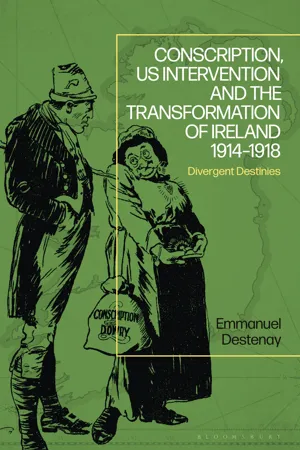![]()
1
Political Crisis, British Intentions and Wartime Uncertainties (January 1913–March 1916)
At the beginning of the twentieth century, constitutional nationalism had progressively imposed itself as a viable political alternative to a more radical and separatist republicanism. Instead of relying on armed insurrection and direct confrontation, members of the Irish Parliamentary Party (IPP) had re-imagined a political strategy that consisted in securing Ireland’s claims through legislative channels. With an overall population of 4,374,500,1 the island appeared to be a single territory on which two peoples coexisted.2 More than a mere geographical and economic divide between the industrialized north and the agricultural south, the ‘polarisation between the protestant north and catholic south’3 both structured and separated the expectations of nationalist and unionist populations. Ulster remained predominantly loyal to the British Crown whereas, in the rest of the country, the majority hoped for the establishment of a parliament in Dublin as advocated by the Home Rule project. Devolution and a certain degree of autonomy spearheaded the manifesto of Irish MPs who, as representatives of Ireland, participated in the elaboration of British domestic policy at Westminster where they sat in the same chamber as the unionist MPs from Ulster.
Home Rule and Ulster Unionism: the impossible settlement
During the 1910 general elections, the Liberals and the Conservatives (with strong unionist sympathies) secured 279 seats each.4 Out of political necessity, the leader of the Liberal Party, Sir Herbert Asquith, offered an alliance to the eighty-four Irish MPs.5 In order to attain a resounding defeat of the Conservative Party candidate, Arthur Balfour (the Liberal candidate), agreed to support the devolution project in exchange for the support of these eighty-four Irish MPs. The Home Rule project stipulated that Ireland would remain a fully-fledged part of the United Kingdom but would benefit from a certain autonomy in domestic affairs. Irish Nationalists therefore sided with the Liberal Party in the hope of achieving their century-long project.6 Asquith’s strategy guaranteed him a convincing victory.
Nevertheless, in order to be able to keep his word, the newly-elected Prime Minister needed to counter the powers of the House of Lords. British constitutional precedent granted the Upper House an unrestricted power of veto on any legislation approved by the Lower House. Even though the House of Commons agreed on the provisions for the proposed devolution of powers to a subordinate Irish legislature, the House of Lords retained its absolute power to veto any Home Rule Bill. This is precisely what had occurred in 1893, when a Home Rule Bill had been presented before the House of Commons and approved, only to be subsequently vetoed by the Upper House which insisted on maintaining Ireland in the United Kingdom. Constitutional Nationalists deplored the systematic opposition of the Lords, while Ulster Unionists relied heavily on the Chamber to protect their existing constitutional position. From a purely legislative point of view, Asquith needed first to silence the House of Lords. He therefore drew up a piece of legislation that would prevent the Lords from vetoing any bill beyond three sessions of parliament.
A few months after his election, the Prime Minister introduced the Parliament Act. The proposed bill stipulated that ‘any measure that had passed in three successive years through the House of Commons would thus automatically become law’.7 When the House of Commons voted the law in 1911, this strategic manoeuvre stirred up vehement protest in Ulster.8 Overnight, the loyalist community found itself deprived of its traditional political support in the Lords and Ulster had no choice but to look on, powerless, as the British Government rewarded constitutional Nationalists with a future status of devolution for the island. Appalled by what they regarded as open treason, Ulster Unionists observed the evolution of the situation with deepening anxiety. In April 1912, the British Government finally introduced the Home Rule Bill before Parliament for the third time. When the House of Commons agreed to offer a degree of autonomy to Ireland, the House of Lords was no longer in a position to counter the Government’s intention. As the Ambassador for France to London, Paul Cambon, observed, ‘Home Rule was the outcome of a parliamentary combination that guaranteed the survival of the Asquith Cabinet’.9
By April 1912, the deal secured between British Liberals and Irish Nationalists was progressively transforming the course of Ireland’s history. This third Home Rule Bill offered a constitutionalized response to the century-long expectations of nationalist Ireland.10 The bill stunned the unionist community and triggered the armed revolt of Ulster. Before the official adoption of the Home Rule project, Ulster Unionists mobilized opposition to what they regarded as treason by the Liberals. In September 1912, 400,000 Unionists signed the Ulster’s Solemn League and Covenant, vowing in the eventuality of the establishment of an autonomous parliament in Dublin to which the north would have to pledge allegiance, to rise against the British Government, and pledging to resist by all necessary means.11 Under the leadership of Sir Edward Carson, loyalist populations pledged their unconditional support to the Crown but openly defied the British Government. Although nationalism had been slowly shifting from a revolutionary strategy to a con...
